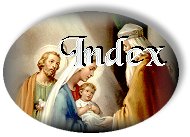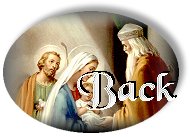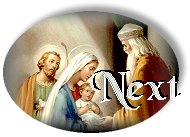CONGREGATION FOR CATHOLIC
EDUCATION CONGREGATION FOR THE CLERGY
BASIC NORMS FOR THE FORMATION
OF PERMANENT DEACONS
DIRECTORY FOR THE MINISTRY AND
LIFE OF PERMANENT DEACONS
LIBRERIA EDITRICE VATICANA VATICAN
CITY 1998
JOINT DECLARATION AND INTRODUCTION
JOINT DECLARATION
The permanent Diaconate, restored by the Second Vatican
Council, in complete continuity with ancient Tradition and the specific
decision of the Council of Trent, has flourished in these last decades
in many parts of the Church — with promising results, especially for the
urgent missionary work of new evangelization. The Holy See and many Episcopates,
in promoting this ecclesial experience, have continually afforded norms
and guidelines for the life and formation of deacons. The growth of the
permanent Diaconate, however, now gives rise to a need for a certain unity
of direction and clarification of concepts, as well as for practical encouragement
and more clearly defined pastoral objectives. The total reality of the
Diaconate — embracing its fundamental doctrinal vision, discernment of
vocation, as well as the life, ministry, spirituality and formation of
deacons — calls for a review of the journey thus far made, so as to arrive
at a global vision of this grade of Sacred Orders corresponding to the
desire and intention of the Second Vatican Council.
Following the publication of the Ratio fundamentalis
institutionis sacerdotalis on priestly formation and the Directory on the
Ministry and Life of Priests, the Congregation for Catholic Education and
the Congregation for the Clergy, completing the treatment of what pertains
to the Diaconate and the Priesthood, the objects of their competence, now
wish to devote particular consideration to the subject of the permanent
Diaconate. Both Congregations, having consulted the Episcopate throughout
the world and numerous experts, discussed the permanent Diaconate at their
Plenary Assemblies in November 1995. The Cardinal Members together with
the Archbishop and Bishop Members carefully considered the various consultations
and numerous submissions made in the matter. As a result, the final texts
of the Ratio fundamentalis institutionis diaconorum permanentium and the
Directory for the Ministry and Life of Permanent Deacons were drafted by
the two Congregations and faithfully reflect points and proposals from
every geographical area represented at the Plenary Assemblies. The work
of both Plenaries illustrated convergence on many points and agreement
concerning the clear need for greater uniformity in training so as to ensure
the pastoral effectiveness of the Sacred Ministry in confronting the challenges
which face it on the eve of the Third Millenium. Therefore, both Dicasteries
were requested to undertake the drafting of these documents which are published
simultaneously and prefaced by a single, comprehensive introduction. The
Ratio fundamentalis institutionis diaconorum permanentium, prepared by
the Congregation for Catholic Education, is intended not only as a guideline
for the formation of permanent Deacons but also as a directive of which
due account is to be taken by the Episcopal Conferences when preparing
their respective "Rationes". As with the Ratio fundamentalis institutionis
sacerdotalis, the Congregation offers this aid to the various Episcopates
to facilitate them in discharging adequately the prescriptions of canon
236 of the Code of Canon Law and to ensure for the Church, unity, earnestness
and completeness in the formation of permanent Deacons.
The Directory for the Ministry and Life of Permanent
Deacons, as in the case of the Directory on the Ministry and Life of Priests,
has, together with its hortative character, juridically binding force where
its norms "recall disciplinary norms of the Code of Canon Law" or "determine
with regard to the manner of applying universal laws of the Church, explicitate
their doctrinal basis and inculcate or solicit their faithful observance".(1)
In these specific cases, it is to be regarded as a formal, general, executory
Decree (cf. canon 32).
While retaining their proper identity and their own
specific juridical quality, both of these documents, published with the
authority of the respective Dicasteries, mutually reflect and complete
each other by virtue of their logical continuity. It is to be hoped that
they will be presented, received and applied everywhere in their entirety.
The introduction, here conjointly published with these documents, is intended
as a reference point and a normative source for both, while remaining an
inextricable part of each document.
The introduction restricts itself to the historical
and pastoral aspects of the permanent Diaconate, with specific reference
to the practical dimension of formation and ministry. The doctrinal reasons
for the arguments advanced are drawn from those expressed in the documents
of the Second Vatican Council and subsequent Magisterium.
The documents produced here are intended as a response
to a widely felt need to clarify and regulate the diversity of approaches
adopted in experiments conducted up to now, whether at the level of discernment
and training or at that of active ministry and ongoing formation. In this
way it will be possible to ensure a certain stability of approach which
takes account of legitimate plurality and in turn guarantees that indispensable
unity, necessary for the success of the ministry of the permanent Diaconate
which has been fruitful and which, at the threshold of the Third Millenium,
promises to make an important contribution to New Evangelization.
The directives contained in the following documents
pertain to permanent deacons of the secular clergy, although many, with
due adaptation, may also to be applied to permanent deacons who are members
of institutes of consecrated life or societies of apostolic life.
INTRODUCTION(2)
I. The Ordained
Ministry
-
1. "In order to shepherd the People of God and to increase
its numbers without cease, Christ the Lord set up in the Church a variety
of offices which aim at the good of the whole body. The holders of office,
who are invested with a sacred power, are, in fact, dedicated to promoting
the interests of their brethren, so that all who belong to the People of
God, and are consequently endowed with true Christian dignity, may, through
their free and well-ordered efforts towards a common goal, attain to salvation".(3)
The Sacrament of Orders "configures the recipient
to Christ by a special grace of the Holy Spirit, so that he may serve as
Christ's instrument for his Church. By ordination he is enabled to act
as a representative of Christ, Head of the Church, in his triple office
of priest, prophet and king".(4)
Through the Sacrament of Orders, the mission entrusted
by Christ to his Apostles continues to be exercised in the Church until
the end of time. It is thus the sacrament of apostolic ministry.(5)
The sacramental act of ordination surpasses mere election,
designation or delegation by the community, because it confers a gift of
the Holy Spirit enabling the exercise of sacred power which can only come
from Christ himself through his Church.(6)
"The one sent by the Lord does not speak and act of
his own authority, but by virtue of Christ's authority; not as a member
of the community but speaking to it in the name of Christ. No one can bestow
grace on himself; it must be given and offered. This fact presupposes ministers
of grace, authorized and empowered by Christ".(7)
The sacrament of apostolic ministry comprises three
degrees. Indeed "the divinely instituted ecclesiastical ministry is exercised
in different degrees by those who even from ancient times have been called
bishops, priests and deacons".(8)
Together with priests and deacons as their helpers,
the bishops have received pastoral charge of the community, and preside
in God's stead over the flock of which they are shepherds in as much as
they are teachers of doctrine, priests of sacred worship and ministers
of pastoral government.(9)
The sacramental nature of ecclesial ministry is such
that it has "intrinsically linked...its character of service. Entirely
dependant on Christ who gives mission and authority, ministers are truly
"slaves of Christ" (cf. Rom. 1:11), in the image of him who freely took
"the form of a slave" for us (cf. Phil. 2:7)".(10)
The sacred ministry also has a collegial form(11)
and a personal character(12) by which "sacramental ministry in the Church...is
at once a collegial and a personal service, exercised in the name of Christ".(13)
II. The Diaconate
-
2. The service of deacons in the Church is documented
from apostolic times. A strong tradition, attested already by St. Ireneus
and influencing the liturgy of ordination, sees the origin of the diaconate
in the institution of the "seven" mentioned in the Acts of the Apostles
(6:1-6). Thus, at the initial grade of sacred hierarchy are deacons, whose
ministry has always been greatly esteemed in the Church.(14) St. Paul refers
to them and to the bishops in the exordium of his Epistle to the Philippians
(cf. Phil 1:1), while in his first Epistle to Timothy he lists the qualities
and virtues which they should possess so as to exercise their ministry
worthily (cf. 1 Tim 3:8-13).(15)
From its outset, patristic literature witnesses to
this hierarchical and ministerial structure in the Church, which includes
the diaconate. St Ignatius of Antioch(16) considers a Church without bishop,
priest or deacon, unthinkable. He underlines that the ministry of deacons
is nothing other than "the ministry of Jesus Christ, who was with the Father
before time began and who appeared at the end of time". They are not deacons
of food and drink but ministers of the Church of God. The Didascalia Apostolorum,(17)
the Fathers of subsequent centuries, the various Councils(18) as well as
ecclesiastical praxis(19) all confirm the continuity and development of
this revealed datum.
Up to the fifth century the Diaconate flourished in
the western Church, but after this period, it experienced, for various
reasons, a slow decline which ended in its surviving only as an intermediate
stage for candidates preparing for priestly ordination.
The Council of Trent disposed that the permanent Diaconate,
as it existed in ancient times, should be restored, in accord with its
proper nature, to its original function in the Church.(20) This prescription,
however, was not carried into effect.
The second Vatican Council established
that "it will
be possible for the future to restore the diaconate as a proper and permanent
rank of the hierarchy....(and confer it) even upon married men, provided
they be of more mature age, and also on suitable young men for whom, however,
the law of celibacy must remain in force",(21) in accordance with constant
tradition. Three reasons lay behind this choice: (i) a desire to enrich
the Church with the functions of the diaconate, which otherwise, in many
regions, could only be exercised with great difficulty; (ii) the intention
of strengthening with the grace of diaconal ordination those who already
exercised many of the functions of the Diaconate; (iii) a concern to provide
regions, where there was a shortage of clergy, with sacred ministers. Such
reasons make clear that the restoration of the permanent Diaconate was
in no manner intended to prejudice the meaning, role or flourishing of
the ministerial priesthood, which must always be fostered because of its
indispensability.
With the Apostolic Letter Sacrum diaconatus ordinem(22)
of 18 June 1967, Pope Paul VI implemented the recommendations of the Second
Vatican Council by determining general norms governing the restoration
of the permanent Diaconate in the Latin Church. The Apostolic Constitution
Pontificalis Romani Recognitio(23) of 18 June 1968 approved the new rite
of conferring the Sacred Orders of the Episcopate, the Presbyterate and
the Diaconate and determined the matter and form of these sacramental ordinations.
Finally, the Apostolic Letter Ad pascendum(24) of 15 August 1972 clarified
the conditions for the admission and ordination of candidates to the diaconate.
The essential elements of these norms subsequently passed into the Code
of Canon Law promulgated by Pope John Paul II on 25 January 1983.(25)
In the wake of this universal legislation, several
Episcopal Conferences, with the prior approbation of the Holy See, have
restored the permanent Diaconate in their territories and have drawn up
complementary norms for its regulation.
III. The Permanent
Diaconate
-
3. The experience of the Church over several centuries
has generated the norm of conferring the priesthood only on those who have
already received the Diaconate and exercised it appropriately.(26) The
Order of deacons, however, "should not be considered merely a step towards
the Priesthood".(27)
"One of the fruits of the Second Vatican Council was
the desire to restore the diaconate as a proper and stable rank of the
hierarchy".(28) On the basis of the "historical circumstances and pastoral
purposes noted by the Council Fathers, the Holy Spirit, protagonist of
the Church's life, worked mysteriously to bring about a new and more complete
actualization of the hierarchy which traditionally consists of bishops,
priests and deacons. In this manner the Christian community was revitalized,
configured more closely to that of the Apostles which, under the influence
of the Paraclete, flourished as the Acts of the Apostles(29) testifies.
The permanent Diaconate is an important enrichment
for the mission of the Church.(30) Since the munera proper to deacons are
necessary to the Church's life,(31) it is both convenient and useful, especially
in mission territories,(32) that men who are called to a truly diaconal
ministry in the Church, whether liturgical or pastoral, charitable or social,
"be strengthened by the imposition of hands, which has come down from the
Apostles, and more closely united to the altar so as to exercise their
ministry more fruitfully through the sacramental grace of the diaconate".(33)
Vatican City, 22 February 1998, Feast
of the Chair of Peter.
Congregation for Catholic Education
Pio Card. Laghi
Prefect
+ José Saraiva Martins
Titular Archbishop of Tuburnica
Secretary
Congregation for the Clergy
Darío Card. Castrillón
Hoyos
Prefect
+ Csaba Ternyák
Titular Archbishop of Eminenziana
Secretary




